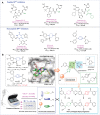Miniaturized Modular Click Chemistry-enabled Rapid Discovery of Unique SARS-CoV-2 Mpro Inhibitors With Robust Potency and Drug-like Profile
- PMID: 39319611
- PMCID: PMC11578313
- DOI: 10.1002/advs.202404884
Miniaturized Modular Click Chemistry-enabled Rapid Discovery of Unique SARS-CoV-2 Mpro Inhibitors With Robust Potency and Drug-like Profile
Abstract
The COVID-19 pandemic has required an expeditious advancement of innovative antiviral drugs. In this study, focused compound libraries are synthesized in 96- well plates utilizing modular click chemistry to rapidly discover potent inhibitors targeting the main protease (Mpro) of SARS-CoV-2. Subsequent direct biological screening identifies novel 1,2,3-triazole derivatives as robust Mpro inhibitors with high anti-SARS-CoV-2 activity. Notably, C5N17B demonstrates sub-micromolar Mpro inhibitory potency (IC50 = 0.12 µM) and excellent antiviral activity in Calu-3 cells determined in an immunofluorescence-based antiviral assay (EC50 = 0.078 µM, no cytotoxicity: CC50 > 100 µM). C5N17B shows superior potency to nirmatrelvir (EC50 = 1.95 µM) and similar efficacy to ensitrelvir (EC50 = 0.11 µM). Importantly, this compound displays high antiviral activities against several SARS-CoV-2 variants (Gamma, Delta, and Omicron, EC50 = 0.13 - 0.26 µM) and HCoV-OC43, indicating its broad-spectrum antiviral activity. It is worthy that C5N17B retains antiviral activity against nirmatrelvir-resistant strains with T21I/E166V and L50F/E166V mutations in Mpro (EC50 = 0.26 and 0.15 µM, respectively). Furthermore, C5N17B displays favorable pharmacokinetic properties. Crystallography studies reveal a unique, non-covalent multi-site binding mode. In conclusion, these findings substantiate the potential of C5N17B as an up-and-coming drug candidate targeting SARS-CoV-2 Mpro for clinical therapy.
Keywords: SARS‐CoV‐2; click chemistry; direct screening; main protease; miniaturized synthesis; non‐covalent inhibitors.
© 2024 The Author(s). Advanced Science published by Wiley‐VCH GmbH.
Conflict of interest statement
The authors declare no conflict of interest.
Figures












References
-
- Zhou P., Yang X. L., Wang X. G., Hu B., Zhang L., Zhang W., Si H. R., Zhu Y., Li B., Huang C. L., Chen H. D., Chen J., Luo Y., Guo H., Jiang R. D., Liu M. Q., Chen Y., Shen X. R., Wang X., Zheng X. S., Zhao K., Chen Q. J., Deng F., Liu L. L., Yan B., Zhan F. X., Wang Y. Y., Xiao G. F., Shi Z. L., Nature 2020, 579, 270. - PMC - PubMed
-
- W. H. O. Coronavirus, (COVID‐19) Dashboard , https://covid19.who.int/, (accessed: April 2024).
-
- Fukuda Y., Togashi A., Hirakawa S., Yamamoto M., Fukumura S., Nawa T., Honjo S., Kunizaki J., Nishino K., Tanaka T., Kizawa T., Yamamoto D., Takeuchi R., Sasaoka Y., Kikuchi M., Ito T., Nagai K., Asakura H., Kudou K., Yoshida M., Nishida T., Tsugawa T., J. Med. Virol. 2023, 95, e29299. - PubMed
MeSH terms
Substances
Grants and funding
- Key Research and Development Program
- 2023YFC2606500/Ministry of Science and Technology of the People's Republic of China
- SYS202205/Shandong Laboratory Program
- ZR2021ZD17/Major Basic Research Project of Shandong Provincial Natural Science Foundation
- 82373727/National Natural Science Foundation of China
LinkOut - more resources
Full Text Sources
Medical
Miscellaneous
